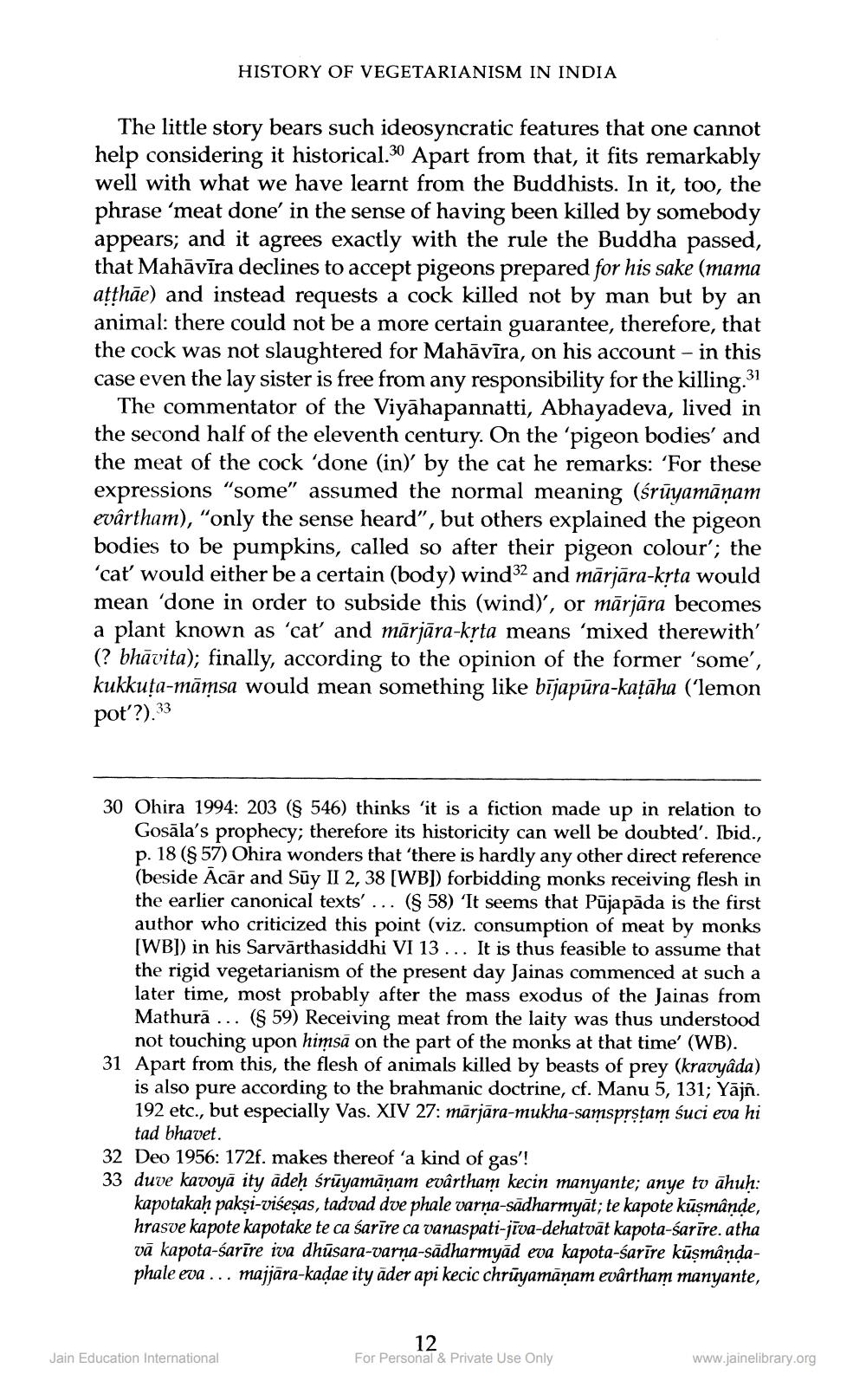________________
HISTORY OF VEGETARIANISM IN INDIA
The little story bears such ideosyncratic features that one cannot help considering it historical.30 Apart from that, it fits remarkably well with what we have learnt from the Buddhists. In it, too, the phrase 'meat done' in the sense of having been killed by somebody appears; and it agrees exactly with the rule the Buddha passed, that Mahāvīra declines to accept pigeons prepared for his sake (mama atthāe) and instead requests a cock killed not by man but by an animal: there could not be a more certain guarantee, therefore, that the cock was not slaughtered for Mahāvīra, on his account - in this case even the lay sister is free from any responsibility for the killing 31
The commentator of the Viyāhapannatti, Abhayadeva, lived in the second half of the eleventh century. On the 'pigeon bodies' and the meat of the cock ‘done (in) by the cat he remarks: “For these expressions "some" assumed the normal meaning (śrūyamāņam evârtham), "only the sense heard", but others explained the pigeon bodies to be pumpkins, called so after their pigeon colour'; the 'cat' would either be a certain (body) wind32 and mārjāra-krta would mean 'done in order to subside this (wind)', or mārjāra becomes a plant known as 'cat' and mārjāra-krta means 'mixed therewith' (? bhāvita); finally, according to the opinion of the former 'some', kukkuța-māņsa would mean something like bījapūra-kațāha ('lemon
pot'?).33
30 Ohira 1994: 203 (8 546) thinks it is a fiction made up in relation to
Gosāla's prophecy; therefore its historicity can well be doubted'. Ibid., p. 18 (8 57) Ohira wonders that there is hardly any other direct reference (beside Acār and Sūy II 2, 38 [WB]) forbidding monks receiving flesh in the earlier canonical texts' ... (8 58) 'It seems that Pūjapāda is the first author who criticized this point (viz. consumption of meat by monks [WB]) in his Sarvārthasiddhi VI 13... It is thus feasible to assume that the rigid vegetarianism of the present day Jainas commenced at such a later time, most probably after the mass exodus of the Jainas from Mathurā ... (8 59) Receiving meat from the laity was thus understood
not touching upon himsā on the part of the monks at that time' (WB). 31 Apart from this, the flesh of animals killed by beasts of prey (kravyâda)
is also pure according to the brahmanic doctrine, cf. Manu 5, 131; Yājñ. 192 etc., but especially Vas. XIV 27: marjāra-mukha-samsprstam suci eva hi
tad bhavet. 32 Deo 1956: 172f. makes thereof a kind of gas'! 33 duve kavoyā ity adeḥ śrüyamāņam evârtham kecin manyante; anye tv ähuh:
kapotakaḥ pakși-viseșas, tadvad dve phale varņa-sādharmyāt; te kapote kūşmânde, hrasve kapote kapotake te ca śarīre ca vanaspati-jīva-dehatvāt kapota-śarīre. atha vā kapota-śarīre iva dhūsara-varna-sādharmyād eva kapota-śarīre kūşmândaphale eva... majjara-kadae ity äder api kecic chrūyamānam evârtham manyante,
12 For Personal & Private Use Only
Jain Education International
www.jainelibrary.org




